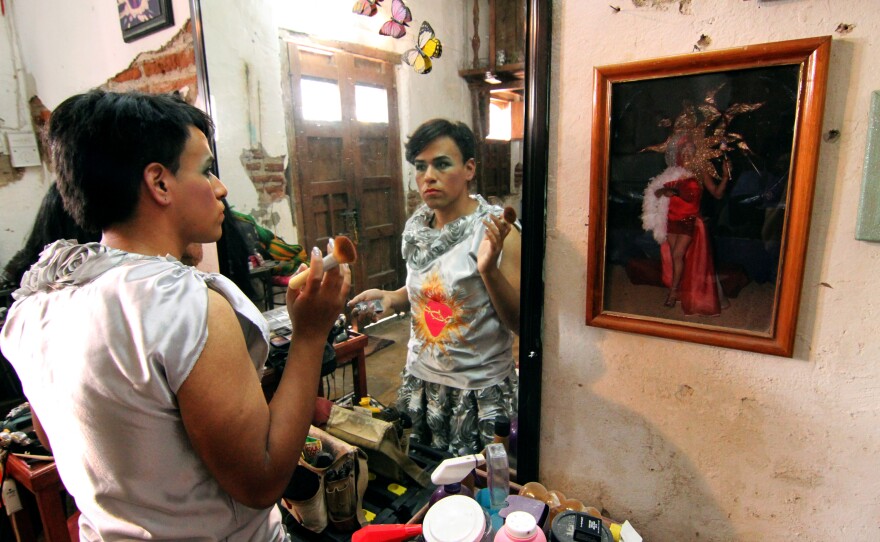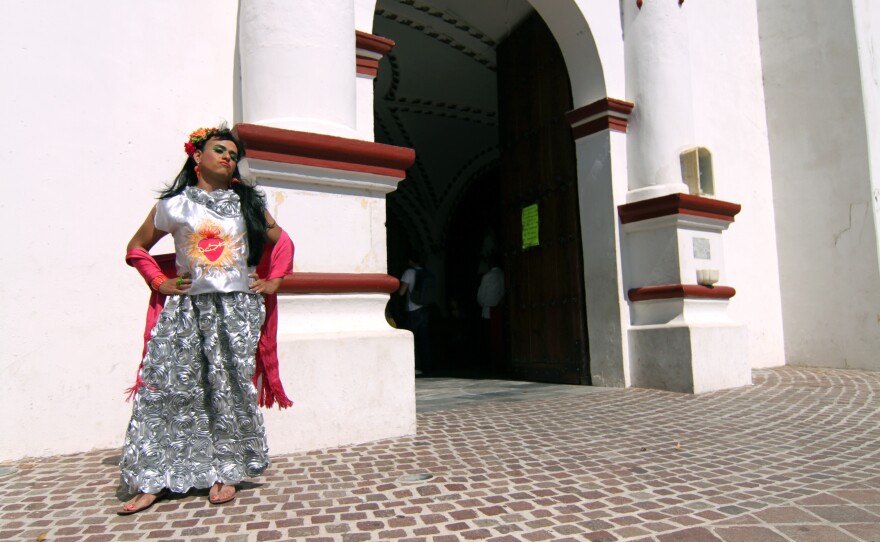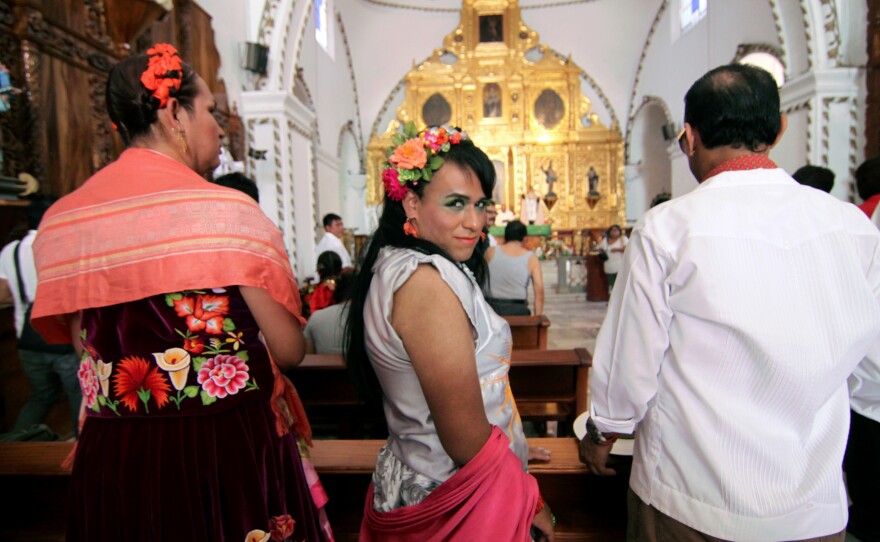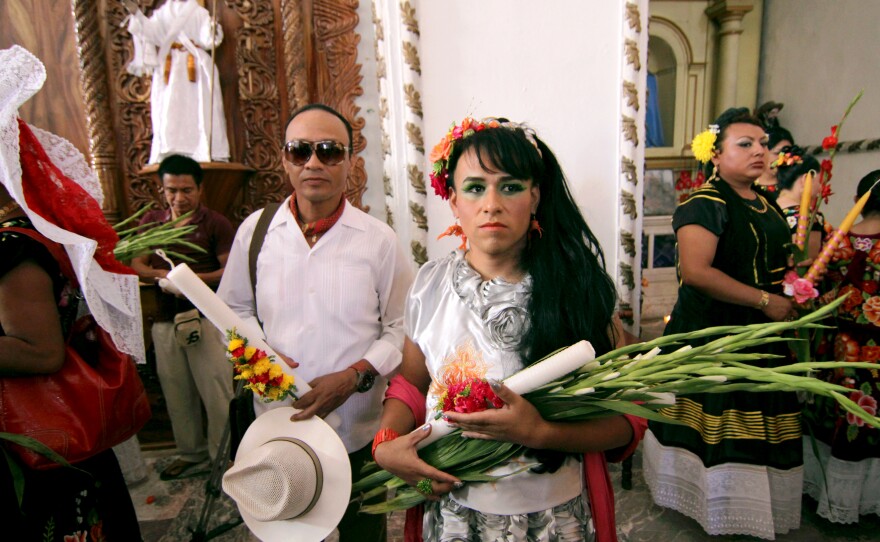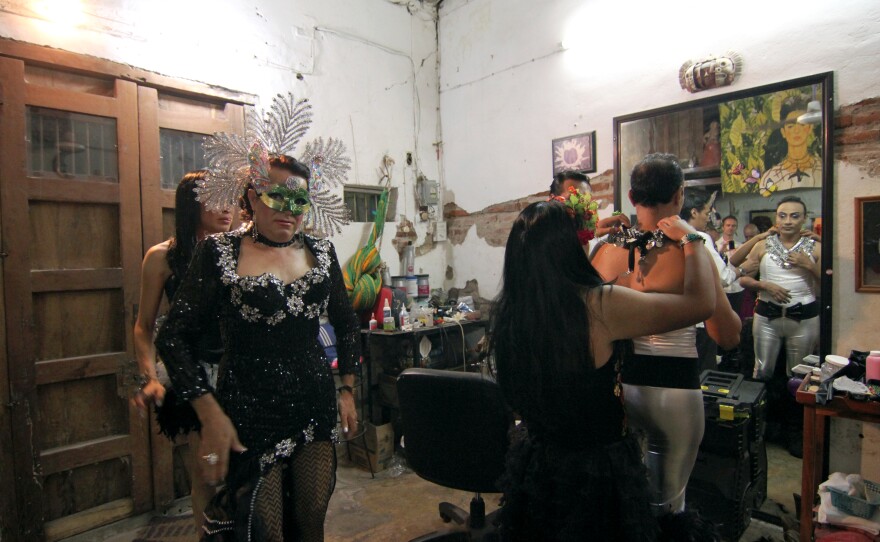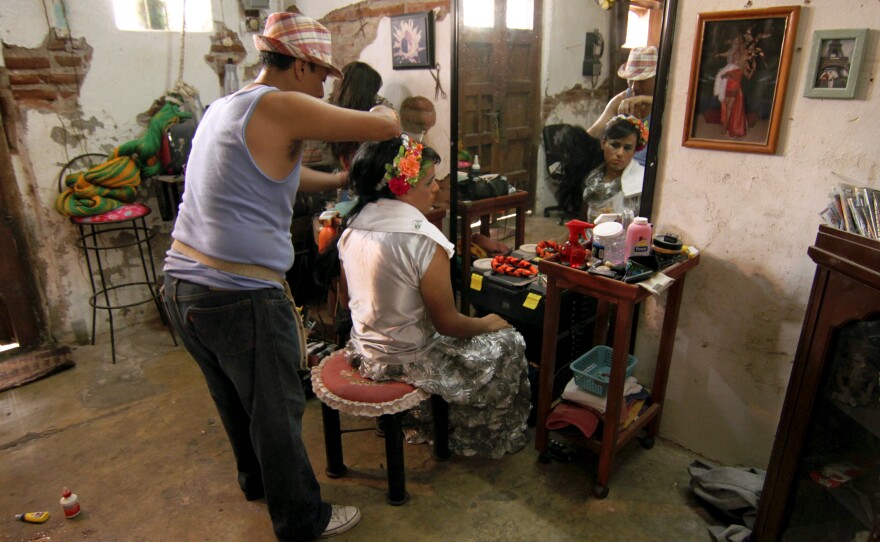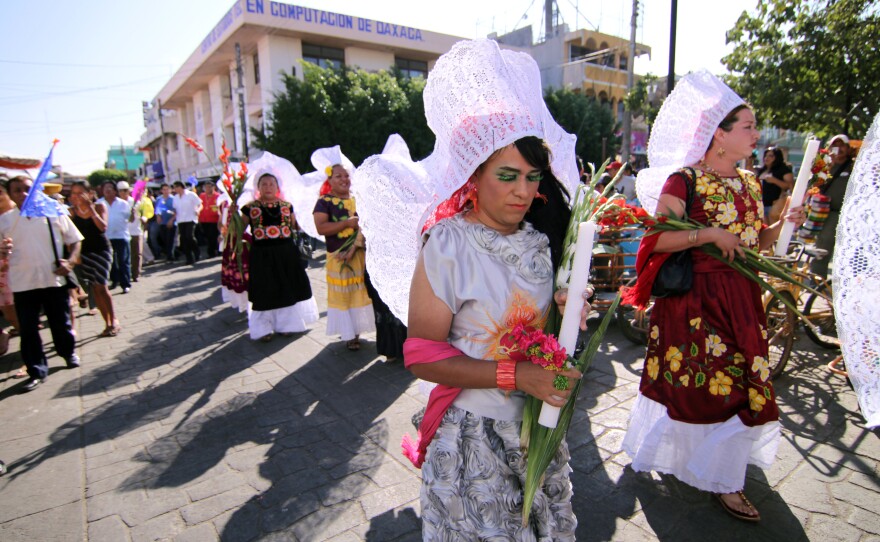Alex Hernandez was born in Oaxaca, Mexico. By age 4, he had immigrated to the United States with his family. By age 12, he had asked his mother if he could sew. She refused, he recalls, saying sewing was for girls.
So he chose a different creative route. By high school, Hernandez was painting; in college, embroidering.
A few years later, Hernandez, now a textile and embroidery artist, returned to Oaxaca for a three-day festival called Vela de Las Intrepidas — or Vigil of the Intrepids. Created in the 1970s, the festival is a celebration of ambiguity and mixed gender identities, and for Hernandez, it was like a rite of passage.
The indigenous Zapotec culture of Oaxaca is not divided by the usual dichotomies: gay or straight, male or female. There's a commonly accepted third category of mixed gender — people called muxes. (said to derive from mujer — Spanish for "woman"). Some are men who live as women, or who identify beyond a single gender.
1 of 12
— This photo series by Neil Rivas documents the journey of artist Alex Hernandez as he participates in "Vela de las Intrepidas" — or "Vigil of the Intrepids" — a festival celebrating the "muxe" culture.
This photo series by Neil Rivas documents the journey of artist Alex Hernandez as he participates in "Vela de las Intrepidas" — or "Vigil of the Intrepids" — a festival celebrating the "muxe" culture.
/ Neil Rivas
2 of 12
— This photo series by Neil Rivas documents the journey of artist Alex Hernandez as he participates in "Vela de las Intrepidas" — or "Vigil of the Intrepids" — a festival celebrating the "muxe" culture.
This photo series by Neil Rivas documents the journey of artist Alex Hernandez as he participates in "Vela de las Intrepidas" — or "Vigil of the Intrepids" — a festival celebrating the "muxe" culture.
/ Neil Rivas
3 of 12
— This photo series by Neil Rivas documents the journey of artist Alex Hernandez as he participates in "Vela de las Intrepidas" — or "Vigil of the Intrepids" — a festival celebrating the "muxe" culture.
This photo series by Neil Rivas documents the journey of artist Alex Hernandez as he participates in "Vela de las Intrepidas" — or "Vigil of the Intrepids" — a festival celebrating the "muxe" culture.
/ Neil Rivas
4 of 12
— This photo series by Neil Rivas documents the journey of artist Alex Hernandez as he participates in "Vela de las Intrepidas" — or "Vigil of the Intrepids" — a festival celebrating the "muxe" culture.
This photo series by Neil Rivas documents the journey of artist Alex Hernandez as he participates in "Vela de las Intrepidas" — or "Vigil of the Intrepids" — a festival celebrating the "muxe" culture.
/ Neil Rivas
5 of 12
— This photo series by Neil Rivas documents the journey of artist Alex Hernandez as he participates in "Vela de las Intrepidas" — or "Vigil of the Intrepids" — a festival celebrating the "muxe" culture.
This photo series by Neil Rivas documents the journey of artist Alex Hernandez as he participates in "Vela de las Intrepidas" — or "Vigil of the Intrepids" — a festival celebrating the "muxe" culture.
/ Neil Rivas
6 of 12
— This photo series by Neil Rivas documents the journey of artist Alex Hernandez as he participates in "Vela de las Intrepidas" — or "Vigil of the Intrepids" — a festival celebrating the "muxe" culture.
This photo series by Neil Rivas documents the journey of artist Alex Hernandez as he participates in "Vela de las Intrepidas" — or "Vigil of the Intrepids" — a festival celebrating the "muxe" culture.
/ Neil Rivas
7 of 12
— This photo series by Neil Rivas documents the journey of artist Alex Hernandez as he participates in "Vela de las Intrepidas" — or "Vigil of the Intrepids" — a festival celebrating the "muxe" culture.
This photo series by Neil Rivas documents the journey of artist Alex Hernandez as he participates in "Vela de las Intrepidas" — or "Vigil of the Intrepids" — a festival celebrating the "muxe" culture.
/ Neil Rivas
8 of 12
— This photo series by Neil Rivas documents the journey of artist Alex Hernandez as he participates in "Vela de las Intrepidas" — or "Vigil of the Intrepids" — a festival celebrating the "muxe" culture.
This photo series by Neil Rivas documents the journey of artist Alex Hernandez as he participates in "Vela de las Intrepidas" — or "Vigil of the Intrepids" — a festival celebrating the "muxe" culture.
/ Neil Rivas
9 of 12
— This photo series by Neil Rivas documents the journey of artist Alex Hernandez as he participates in "Vela de las Intrepidas" — or "Vigil of the Intrepids" — a festival celebrating the "muxe" culture.
This photo series by Neil Rivas documents the journey of artist Alex Hernandez as he participates in "Vela de las Intrepidas" — or "Vigil of the Intrepids" — a festival celebrating the "muxe" culture.
/ Neil Rivas
10 of 12
— This photo series by Neil Rivas documents the journey of artist Alex Hernandez as he participates in "Vela de las Intrepidas" — or "Vigil of the Intrepids" — a festival celebrating the "muxe" culture.
This photo series by Neil Rivas documents the journey of artist Alex Hernandez as he participates in "Vela de las Intrepidas" — or "Vigil of the Intrepids" — a festival celebrating the "muxe" culture.
/ Neil Rivas
11 of 12
— This photo series by Neil Rivas documents the journey of artist Alex Hernandez as he participates in "Vela de las Intrepidas" — or "Vigil of the Intrepids" — a festival celebrating the "muxe" culture.
This photo series by Neil Rivas documents the journey of artist Alex Hernandez as he participates in "Vela de las Intrepidas" — or "Vigil of the Intrepids" — a festival celebrating the "muxe" culture.
/ Neil Rivas
12 of 12
— This photo series by Neil Rivas documents the journey of artist Alex Hernandez as he participates in "Vela de las Intrepidas" — or "Vigil of the Intrepids" — a festival celebrating the "muxe" culture.
This photo series by Neil Rivas documents the journey of artist Alex Hernandez as he participates in "Vela de las Intrepidas" — or "Vigil of the Intrepids" — a festival celebrating the "muxe" culture.
/ Neil Rivas
Participating in a muxe celebration with Mexican roots was like "reclaiming a role that was lost in time," Hernandez says.
Hernandez came out to his mother when he was 15. "Don't tell anybody," he recalls her saying to him. After that, he says, he struggled to define his role in the family.
While his sister had a clearly defined place as the daughter of their family — to marry and have children — there was no expectation of his role once he told his family he was gay.
Learning about muxeschanged that for him.
According to The New York Times, some "trace the acceptance of people of mixed gender to pre-Columbian Mexico, pointing to accounts of cross-dressing Aztec priests and Mayan gods who were male and female at the same time."
Photographer Neil Rivas, who met Hernandez at California College of the Arts, says he felt empowered to find "this history that I didn't know."
So the two traveled to Mexico to document the festival experience. In Rivas' photos, Hernandez wears his own creations — dresses with traditional Catholic symbols like the sacred heart — and incorporates modern drag elements such as false eyelashes, glitter and makeup.
The images capture Hernandez in his personal transformation — as well as blurred lines between gay and Catholic cultures, lines he was not encouraged to cross as a child. But in Juchitan de Zaragoza, where the festival is held, some Catholic priests hold services for muxes.
"They have an important role," says Hernandez. "They take care of their parents. ... It was nice to know that ... there's this history where queer people had special roles in society."
And Rivas says he hopes the photos will expand perspectives about modern queer culture.
"I was more than impressed with all the work that the muxes do. ... There's good reason for why they're often referred to as the Intrepidas," he says.
The project, "Searching for Queertopia," is on display at San Francisco's Galeria de la Raza through the end of June.
Copyright 2021 NPR. To see more, visit https://www.npr.org. 9(MDA4NjIwNTkwMDEzMjI4NDY0MjY4ZTBlNA004))
9(MDA4NjIwNTkwMDEzMjI4NDY0MjY4ZTBlNA004))





